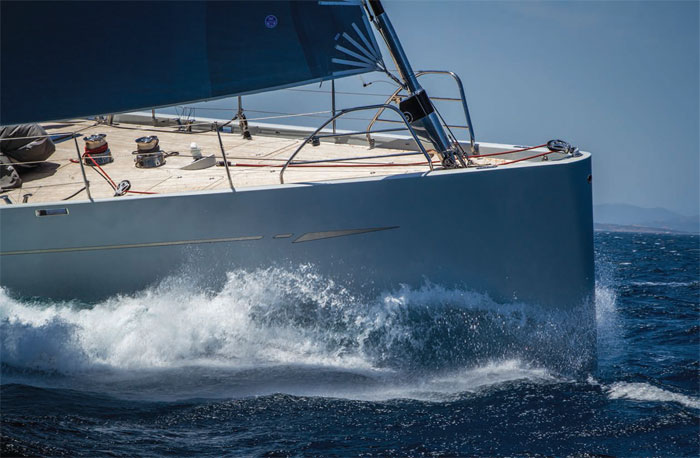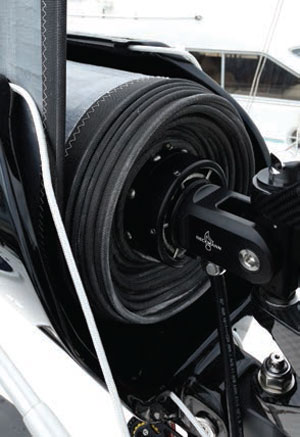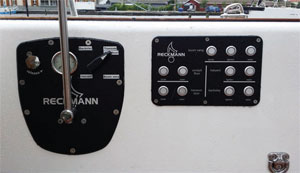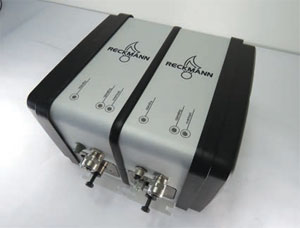

Bigger yachts, greater loads, fewer crew yet easier sailing. One reason that in 2022 such a bizarre and seemingly conflicting combination of features is possible can simply be described as ‘Reckmann’
There is a long-term trend in sailing and especially in cruising. Boats are getting bigger and crews are getting smaller. It’s now quite common for a novice sailor’s first yacht to be more than 50ft or even 65ft long. Most new cruising boats in that size bracket are designed to be sailed by a couple who may not have a lot of experience, without any other crew on board. Even with the full benefit of today’s technologies, this style of short-handed, push-button sailing can be extremely dangerous if you don’t have totally reliable, guaranteed failsafe sail-handling hardware and systems. And that’s where Reckmann comes in.
‘When you sail offshore in a large yacht with a shorthanded crew, your life quite literally depends on a complex, integrated system of mechanical, electric, hydraulic and electronic components,’ says Marcus Schuldt, chief executive of Reckmann. ‘For previous generations of sailors that would have been unthinkable but the solutions we offer make it feasible today.’
Reckmann’s headsail furlers are widely regarded as the best on the market and renowned for their rocksolid reliability. But they are just one part of a broad and versatile suite of sail-handling and rigging hardware – hydraulic cylinders, electric pumps and valves, MCUs, boom drives and more. Each of these is designed and manufactured to Reckmann’s exacting standards and can be relied upon to deliver extremely high levels of performance and reliability.
Hydraulic cylinders have an essential role on many large cruising yachts. ‘Our cylinders are made to work with pressure up to 440bar to achieve very compact and lightweight products,’ Schuldt explains. ‘All other brands go up to 350bar maximum. We also produce custom cylinders to meet special requests in addition to our standard range.’
Reckmann has developed a range of electric pumps specifically for its cylinders and drives, with manual pumps for backup. ‘The HPS is very quiet, very fast and compact,’ Schuldt says. ‘The good thing is that it is made in a modular design. This means you can add an HPS200 to an existing HPS200 and you have a HPS400 with double the performance. You can even make a HPS600 to operate bigger boom vangs.’
Boomfurl drive units for in-boom mainsail furling are an important part of Reckmann’s product suite. ‘The new front drive motor has many advantages over drives that are mounted in the outboard end of the boom,’ Schuldt says. ‘Our drive units were designed to achieve four main goals: reliability, better weight balance, a weight reduction within the structure of the boom and a reliable, high-load clutch integrated in the furling unit. Some of the leading brands of furling booms have already installed our drives and they are happy with the performance and service.’
A front-drive motor can make the boom effectively stronger. The most common cause of boom damage is an accidental gybe, when all of the boom’s kinetic energy is transferred as a shock load to the gooseneck. By relocating a significant weight from the outboard end to the inboard end of the boom, the torsional force on the gooseneck during an uncontrolled gybe is reduced.
Mounting the drive at the inboard end also allows the construction of the boom itself to be lighter and less complex. There is no need for oil supply tubes to run all the way through the boom, for example, which saves weight and reduces the risk of oil leakage inside the boom. The integrated clutch again saves weight, and the boom does not have to withstand torque loads at the shelf. Removing weight from the boom – and especially at its outboard end – can also improve the set of the mainsail in the often troublesome combination of light wind and ocean swell.
Assembly and maintenance costs are reduced because both the aft bearing and the front drive are easy to fit and service. A further benefit is that the forward end of the boom can be left open, allowing the crew to visually monitor the furl as it happens.
Reckmann boom drives also have an integrated cunningham function, which brings its own benefits. ‘The trim of the reefed mainsail comes very close to that of a slab-reefing system,’ Schuldt explains. ‘There is no need for extra lashings through the luff of the sail and it allows the skipper or helmsman to control the cunningham from the helm pedestal.’
While all of these products can and often do operate as stand-alone devices, they deliver further benefits when installed together in a fully integrated sail-handling system. Reckmann has market-leading expertise in delivering integrated solutions as well as manufacturing components.

Above: Reckmann’s new Boomfurl drives have the motor near the gooseneck to minimise its pitching moment and reduce the shock load of a crash gybe.
Some of the leading spar makers use Reckmann furling hardware in their in-mast and in-boom furling systems, but Reckmann also offers its own range of integrated mainsail furling solutions. These include the RMR in-mast furling system, which has been refined over four decades and is built from the same key components as Reckmann’s renowned RF90 headsail systems.
‘Our drives offer an easy-tooperate manual backup system by inserting a standard winch handle from the outside,’ Schuldt explains. ‘This special clutch system disengages the hydraulic motor from the luff rod system with no load on the winch handle from the sail at any time. The second gear step makes the manual backup three times faster. This means a quick and safe emergency manual backup system.’
‘A gooseneck bearing takes the entire load of the luff rod system. This means the hydraulic mast drive, which is connected with a universal joint, works with no pull or bending loads from the sail/luff rod system.’
Reckmann supplies its electric and hydraulic Boomfurl drives to spar makers, but also sells them direct, pre-installed in a Furlerboom or Mainfurl boom. These can then be integrated with Reckmann’s Furlfind automatic boom positioning system which prevents the common scenario of a jammed mainsail caused by a poorly aligned boom.
‘For an experienced crew there is nothing wrong with operating sail-handling hydraulics separately,’ Schuldt says. ‘But an integrated system, where a single button is pushed to operate an entire installation such as a mainsail handling system, is a real advantage and safety factor for a short-handed crew with less experience. These systems allow people who might struggle with the complexity of separate hydraulic functions to operate a large vessel safely.’
Furlfind has benefits for experienced sailors too. ‘At night, it is an advantage for any sailor to push one button and bring the boom into precisely the right position to furl the mainsail,’ Schuldt says. ‘A green light indicates when the boom is ready to operate the mainsail. This is far easier than to visually check whether the boom position is right.’

Above: Reckmann hydraulics enable small crews to fully control their sails and rig from the helm.
Below: HPS pumps are very quiet, fast, compact and can be installed as a modular system

Furlfind is used on a wide variety of yachts, including Swan and Solaris, Y-Yachts and X-Yachts, to name just a few. The mainsail furling system operates in conjunction with a main halyard on a captive winch. ‘Reckmann deck gear is commonly found on board our yachts due to its functionality and reliability,’ says Baltic Yachts’ EVP Henry Hawkins.
The Baltic 67PC is specifically designed for fast, short-handed ocean cruising. Its key features include top-down furling code and A sails with captured luffs, aft swept spreaders to avoid the need for runners, low rig loads for such a large, high-performance boat and a deck layout set up for easy sail-handling. Most lines are led aft and the deck winches are controlled from the helm pedestals. Remote controls allow movement around the deck whilst trimming and handling the sails.
When reefing the mainsail, Hawkins explains, ‘the most important action is to ensure that the boom is at the right height before furling to ensure that the sail rolls onto itself perfectly without the luff pushing forward or pulling aft. This can be measured physically on the vang or by way of a sensor. Furlfind takes the guesswork out of it and allows the sail to be furled or unfurled with a single joystick.’
Reckmann sail-handling systems are also ideal for retrofitting on large classic yachts, making them easier and less strenuous to sail. For example, Boomfurl and Furlfind systems were recently installed on a vintage Swan 65. ‘The main advantage is that it is still possible with these reliable systems to sail a boat of this size short-handed,’ the owner says. ‘We can sail our 65- footer with just two crew now, which saves us one or two additional crew. We get older and can still enjoy a comfortable yacht of the size we like.’
‘We do prefer Reckmann products because they are proven, powerful and of high quality,’ he says. ‘We have known the people at Reckmann for decades and have a good and trusting relationship with them. They support us promptly whenever needed. The excellent worldwide service is very important for us.’
Click here for more information on Reckmann »
We invite you to read on and find out for yourself why Seahorse is the most highly-rated source in the world for anyone who is serious about their racing.
To read on simply SIGN up NOW
Take advantage of our very best subscription offer or order a single copy of this issue of Seahorse.
Online at:
www.seahorse.co.uk/shop and use the code TECH20
Or for iPad simply download the Seahorse App at the iTunes store


